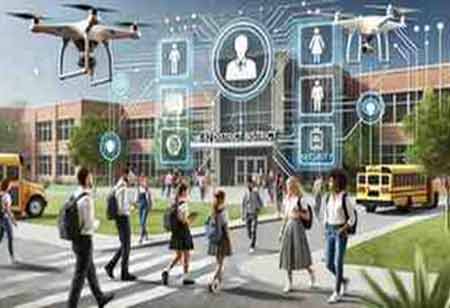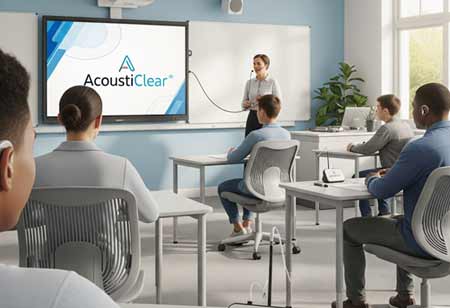THANK YOU FOR SUBSCRIBING
Be first to read the latest tech news, Industry Leader's Insights, and CIO interviews of medium and large enterprises exclusively from Education Technology Insights
Embracing Technology: A New Standard of Safety for K-12 Districts
A secure environment in K-12 schools is becoming increasingly essential, leading to the need for advanced security measures and technologies.

By
Education Technology Insights | Friday, March 21, 2025
Stay ahead of the industry with exclusive feature stories on the top companies, expert insights and the latest news delivered straight to your inbox. Subscribe today.
A secure environment in K-12 schools is becoming increasingly essential, leading to the need for advanced security measures and technologies. Security threats constantly evolve as new equipment and technology are developed to protect the school community. By introducing modern safety systems, making data-driven decisions, and collaborating among administrators, law enforcement, and technology providers, we can transform the security of K-12 districts.
Advances in Surveillance Technology
Modern surveillance systems change the aspect of school security. High-definition cameras and real-time analytics replace the traditional CCTV cameras, allowing for much more effective monitoring of the school grounds by security personnel. K-12 districts have also begun adopting face recognition technology and video analytics powered by artificial intelligence to ensure heightened security while identifying those persons who may not have permission to access buildings or grounds.
Recent advancements in access control systems have replaced traditional systems with cutting-edge technologies like key cards, biometric scans, and mobile applications. These systems effectively secure against unauthorized access and create a free-flowing atmosphere for students and staff within schools, allowing more movement with fewer hindrances.
Emergency notification systems can deliver critical information to students, staff, and responders concerning emergencies in record time, such as lockdowns, gun fires, serious accidents, and other suspicious activities. These alerts are sent via text messages, emails, phone calls, or loudspeaker announcements. The practical efficacy of these systems depends on how fast and accurate their notifications are; hence, they must be so reliable that they reach everyone who needs to know if an emergency occurs.
Technology-based solutions are now being developed into emergency preparedness strategies in the schools. Predictive analysis with data collection tools helps them understand and mitigate risks to security. These tools collect information regarding visitors, security camera footage, and social media activity for potential early identification of threats. This aids school districts in better resource distribution, allowing security officials to focus on the primary threats.
Collaboration and Training for Safety
Collaboration between school districts and law enforcement agencies has also improved overall security. Most K-12 school districts have made direct lines of communication with their local police departments to facilitate quick information sharing and preparation for an emergency. School resource officers (SROs) are integrated into school security, serving law enforcement and educating and counseling students. Their presence helps secure safety as they build networks with students and staff and provides additional strength by giving a psychosocial layer of security.
School safety strategies include mental health support systems to prevent violence and disruptive behaviors. Addressing how students feel and behave is as important as physical safety measures. The comprehensive approach to this provides safety for all students. School districts offer mental health resources to students who experience difficult episodes, ensuring all community members are safe.
K-12 district security embraces using unmanned aerial vehicles, or drones, for real-time monitoring of school grounds. These drones allow a bird' s-eye view of the premises, making it easy for security personnel to monitor vast sections of the schoolyard that would be difficult to cover with stationary cameras. They can also assist during emergencies, such as search-and-rescue operations in the wake of natural disasters or during lockdown events.
Many K-12 districts provide training programs for staff and students to prepare for emergencies in a technology-integrated security environment. These programs include crisis response training, which covers emergency protocols like lockdown procedures and evacuation plans, and active shooter drills that simulate real scenarios and incorporate emergency alert notifications.
Digital safety awareness programs educate students on reporting suspicious behavior and understanding school security technologies. Mental health training focuses on identifying distress signs and promoting help-seeking behavior. Collaboration with school resource officers enhances safety education and communication during emergencies. These programs aim to equip the school community to respond to potential threats effectively.
Funding Challenges and Solutions in School Security
Although technological advancement and funding have improved safety measures in cases of school security, challenges do exist. One requirement is the implementation and maintenance of these systems, which can be rather costly, particularly for budgets that are limited in size. The balance between security and privacy has also been scrutinized, particularly as technology, such as facial recognition and growing surveillance cameras, moves toward greater acceptance.
It is essential to balance these issues to create a safe environment. Schools must learn to counter new threats with emerging technologies, data-based decision-making, and mental health assistance systems to nurture a safe environment where students can grow without fear. K-12 districts adopt advanced technology to bolster school security without compromising privacy, breaking the bank, or getting too cozy with law enforcement for a well-balanced environment.







